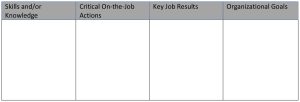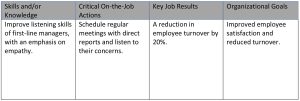
By Steven Just, Ed.D.
What does training success look like?
Learning and development (L&D) practitioners are often told – when designing a training program – that they should begin with this question (or a variation on it) in mind. But there are many L&D stakeholders and the definition of “success” varies from stakeholder to stakeholder.
And who are the stakeholders? The learners themselves, L&D management, sales management (if it is a sales training program), and C-suite executives, among others.
Let’s look at an example:
I take a certification exam. For me “training success” is passing the exam. But what if I got question 17 wrong? Do I care? If I passed the exam, I may not care. But if I failed the exam, I most definitely do care about my lack of “success” on this question.
What about L&D management? Do they care about “success” at the question level? Probably not, unless everyone who took the exam got this question wrong. Then they probably do care. Maybe there’s a problem with the exam question or the training materials. This lack of “success” is something to investigate.
But what about stakeholders in the C-suite? Definitely not! Under no circumstances do they care about this level of training minutiae.
Meeting Goals
What do these corporate leaders care about? We are told that they care about organizational impact, or perhaps return on investment (ROI). But what is the organizational impact?
At a broad level, it is how well the outcomes of training align with company goals. But corporate goals can change over time. Take an example recently in the news: Boeing.
On January 4th (the day before the door blew off their Max 9 jet) no doubt their most important corporate goal was profitability. Today it’s quality control and safety, assuring their stakeholders — the airlines and the flying public – that their planes are safe to fly.
Getting Aligned
So how do you align your training programs with the corporate goals de jour? This is where you, as a learning leader, need to get outside your silo, talk to other leaders within the corporation and understand: what are our current corporate goals?
Most corporations will have multiple goals simultaneously. They could be profitability or expanding market share (not always the same thing). Or they could be, as in the case of Boeing, safety or compliance related. They could be speeding up the process of bringing new products to market or integrating a new workforce from a recent acquisition into your corporate culture.
So, each training program, or perhaps curriculum, could be aligned with a different corporate goal. For example, a safety training program could be aligned with the goal of reducing manufacturing accidents. A sales skills program could be aligned with the goal of increasing market share, and so on.
The Impact Map
How do we make and then keep track of the alignment between training and organizational goals? I recommend the use of an impact map, a tool created by Dr. Robert Brinkerhoff. An impact map allows you to show explicitly the linkages between a training program and the aligned goal. It provides a direct connection from training to performance improvement to organizational goals.
It looks like this:
We fill out the table from right to left. First identify the goal, next the key performance indicators (KPIs) that will enable the company to measure fulfillment of the Goal and then the critical tasks the employees must perform to meet those KPIs. Finally comes the training that is required so the employees can perform those critical tasks.
For example, a company with problematic staff turnover might create a leadership program impact map that looks like this (read from right to left):
Conclusion
By sharing this impact map with senior leadership (the stakeholders) you can demonstrate that you have created and delivered training to directly address a critical corporate need.
Steven Just Ed.D. is the CEO and principal consultant of Princeton Metrics. Dr. Just can be reached at sjust@princetonmetrics.com.










